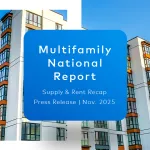Read the latest Yardi Matrix National Multifamily Market Report.
The average U.S. multifamily rent rose 6.2% in 2022, the second-highest annual growth this century.
Report highlights:
- Multifamily rents continued to decrease in December, down $4 to $1,715, representing a 6.2% year-over-year increase.
- In 2023, national rent growth is expected to fall closer to historical levels, conditioned by the demand-supply equation.
- Lifestyle rents continued to lead rent depreciation, down 0.3%; Renter-by-Necessity rents fell 0.1% in December.
- The SFR market posted an annual rent increase of 4.8%, to $2,083, which equals a $8 drop from November.
Overall, 2022 Was a Strong Year
The year 2022 ended with rent growth closer to ‘normal’ levels, up 6.2% year-over-year, to $1,715, which is a $4 drop from November. Although this is the lowest level since May 2021, it marks the second-highest annual growth ever, behind only 2021’s massive growth of nearly 15%. Indianapolis maintained the leading spot among Yardi Matrix’s top 30 metros, up 11.4%. All top 30 metros posted positive annual rent growth, but just in Indianapolis (0.4%) and New York (0.3%) rents rose during the fourth quarter. Nationally, asking rents fell 0.6% in the fourth quarter.
The national multifamily market is expected to fall into more traditional metrics in 2023, highly conditioned by the demand-supply balance. Demand is softening, affected by the cooldown in economic growth paired with the depleting household savings and dwindling post-pandemic migration. Meanwhile, more than 400,000 units are slated to come online in 2023. The bulk of deliveries will affect high population growth metros—Austin, Nashville, Charlotte and Orlando—not only in demand ratio but also in rent growth.
Lifestyle Rents Continue to Drop Harder Than RBN
On a month-over-month basis, the average U.S. asking rent declined 0.2% in December, led by Lifestyle units (-0.3%). Renter-by-Necessity rents slid 0.1%. The average rent decreased by $10 during the quarter. Rent increased only in New York (0.9%), Indianapolis (0.2%) and Houston (0.1%). Furthermore, 28 of the top 30 metros had negative growth in Lifestyle units and 19 posted rent decreases in RBN units. The largest drops were recorded in Boston (-1.1%), Raleigh and the Inland Empire (both -0.9%).
National lease renewals slid to 64.9% in October, on a downward trend since the final quarter of 2021. Leading metros were Philadelphia (77.8%) and Baltimore, and bottom-ranking metros were San Francisco (48.5%) and Los Angeles (49.3%). Meanwhile, renewal rents rose 11.8% year-over-year through October, up 30 basis points from September. This shows that property owners aim to bring rents of existing tenants closer to asking rents. However, with asking rents having turned negative since November, October’s renewal rate might mark the peak of growth. Miami (19.2%), Tampa (18.9%) and Orlando (16.6%) topped the ranking.
Competition Increasing in the Single-Family Built-to-Rent Industry
The asking rent for SFRs increase 4.8% year-over-year in December, to $2,083, down 100 basis points from November. Occupancy decreased 1.4% year-over-year through November but remained unchanged at 95.8%.
The rising mortgage rates dispersed the volume of homebuyers, and some owners turned their listings from sale to rental, adding to the competitive stock for SFRs. John Burns Real Estate Consulting reports that 9% of U.S. home sellers have made this switch in November, with the highest rates of sellers doing so located in the Southwest (17%), Florida (15%) and the Northwest (14%).
Read the full Matrix Multifamily National Report-December 2022











Add Comment